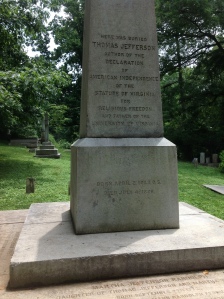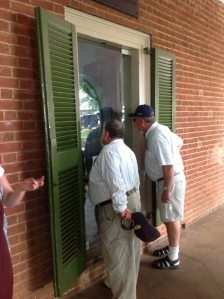After a 2.5-hour drive, we arrived at Montecello, the homeplace of Jefferson. We met with the education staff to review their resources for classrooms, and then we had a brief tour of the museum and displays, where we learned more about Jefferson and his legacy.
Soon after, we took a little bus to the top of the “mountain” to tour the home. The tour guide, a university history intern, gave a great tour of the lower rooms of the home. We toured the grounds, the gardens, and the cemetary where Jefferson was buried.
After Montecello, we ate a southern-cooking lunch at Michie’s Tavern (which most people agreed was the best meal of the trip), and then headed to the University of Virginia campus to see the university sites designed by Jefferson, particularly the “Academical College” and Rotunda he designed. (As a side bonus, we saw the room where Edgar Allen Poe stayed while a student at the university.)
Yes, another great day!
Pictures from Montecello
Pictures from UVA











Thomas Jefferson was a deist. I find it completely ironic that his place is the what I imagine the Garden of Eden looked like. It is the most beautiful place that I have ever seen! His garden was quite remarkable. I couldn’t even begin to imagine having one of those in my back yard. (I know…we don’t have the water that they do here, but WOW!) I learned that he called it his edible lab (or something to that effect). I could smell the herbs and the celery before I even reached the garden. I loved the smell! They have so many wonderful vegetables and herbs growing there. I regret not buying the Jefferson gardening kits and growing one with my students. I will have to look into buying one on-line. His flower beds were beyond beautiful. Every part of his property was full of plants and breathtaking!
While all of this was incredibly impressive, I couldn’t help but feel conflicted as I gazed upon all of his treasures. Here was the man who wrote words that would be the battle cry for many groups fighting for equality in our democracy, “All men were created equal…” but he owned over 600 slaves over the course of his lifetime and he fathered many children with Sally Hemming. He was a great man who contributed so much to our nation. We needed men like him to lead us through this time in our history, yet he was a complete hypocrite. Fifth graders have to write opinion papers and give facts to support their opinions. I already have a plan. This very subject will be the perfect vehicle to do just that! I look forward to their discussions!
Monticello (little mountain) at 850′ is the World Heritage Site of our 3rd President, Thomas Jefferson. What struck me as significant, beyond the obvious beauty of this best documented and living plantation, is the inordinate amount of time the eductional tour guides used in delicately discussing Sally Hemings and TJ’s sexual relationship. Fact: He was the master of over 600 slaves. Fact: Sally was a house slave. Fact: Jefferson was a widower. I was NOT shocked when history had to be revised, but the sensibilities of many were disturbed. Enough.
It has been several years since I visited Monticello, and I noticed a few changes in the tour. As with the Yorktown’s tour guide, the term “enslaved” appeared in speech and on the written information boards. How interesting is our use of semantics! What appears as acceptable in one generation becomes inappropriate or not politically correct in the next generations!
We toured the University of Virginia and saw the beauty of Jefferson’s architecture from sketch to completion. Of special significance was the dormitory room of one of their infamous expelled students, one Edgar Allan Poe.
This entire trip has been a history lover’s living dream, and I have to admit that I haven’t always been a lover of history. My educational experience was the constant droning on of facts, dates, and people that I had no connection with presented by teachers who “taught” history as an afterthought. (You know the type: “I am a football coach, but I have to also teach history so read this chapter so I can focus on the upcoming game,” or “I am counting down my days until retirement so I will teach history because all I have to do is get kids to read and regurgitate the facts—no lesson plan required.”) That is what I brought to the table when I began this whole “getting a Masters in United States History.” Fast forward to over two years of intense readings, papers, presentations, etc. and I get the excitement of history! It is a thrill ride of exciting adventures that never stop! That is the key to teaching history and the key to getting students excited about learning history—tapping into those thrills and adventures! Field trips like the one we have been on are the way to go, literally! I watched hundreds of school kids experiencing Jamestown, Williamsburg, Yorktown, and, today, Monticello, and I wonder do they know how lucky they are to actually be walking on the soil upon which the great leaders of our past have walked? While I may not physically be able to take my students to Monticello, I can let them experience the thrill of the site via the internet. We were fortunate in that we got to spend some time with the Monticello Education Department and found a myriad of ways to tap into the thrills and adventures of Thomas Jefferson. The Thomas Jefferson Foundation provides lesson plans/activities, virtual tours, photos, videos, etc. to allow students to gain a more insightful glimpses into the life of our third president. Lesson plans and primary sources are available via http://www.monticello.org (click on the parents/teachers button-go to Exploring Monticello for a great TJ overview in a booklet format) http://www.classroom.monticello.org (click on for teachers—go to activities—click on build your own slideshow), and http://www.seaofliberty.org. The Sea of Liberty site allows teachers to sign up their classrooms and assign challenges that deal with not only the TJ of the past, but also how his legacy is carried on in present time. Students get a chance to share their creativeness with countless others from around the world. These types of resources are what I wished my teacher’s had access to back when I was in school—maybe then I wouldn’t have missed out on the thrill and adventures of history and would have developed the love of it at a much earlier and impressionable age.